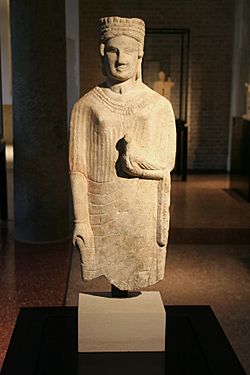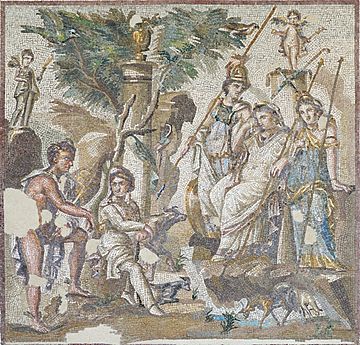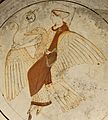Aphrodite facts for kids
Quick facts for kids Aphrodite |
|
|---|---|
| Goddess of love and beauty | |
| Member of the Twelve Olympians | |

Early fifth-century BC statue of Aphrodite from Cyprus, showing her wearing a cylinder crown and holding a dove
|
|
| Abode | Mount Olympus |
| Planet | Venus |
| Animals | dolphin, sparrow, dove, swan, hare, goose, bee, fish, butterfly |
| Symbol | rose, seashell, pearl, mirror, girdle, anemone, lettuce, narcissus |
| Tree | myrrh, myrtle, apple, pomegranate |
| Day | Friday (hēméra Aphrodítēs) |
| Personal information | |
| Consort | Hephaestus (divorced) Ares (unmarried consort) |
| Children | Eros, Phobos, Deimos, Harmonia, Pothos, Anteros, Himeros, Hermaphroditus, Rhodos, Eryx, Peitho, The Graces, Priapus, Aeneas |
| Parents | Zeus and Dione (according to Homer) Uranus (according to Hesiod) |
| Siblings | The Titans, the Hecatoncheires, the Cyclopes, The Meliae, the Erinyes, the Giants (as daughter of Uranus) or Aeacus, Angelos, Apollo, Ares, Artemis, Athena, Dionysus, Eileithyia, Enyo, Eris, Ersa, Hebe, Helen of Troy, Hephaestus, Heracles, Hermes, Minos, Pandia, Persephone, Perseus, Rhadamanthus, the Graces, the Horae, the Litae, the Muses, the Moirai (as daughter of Zeus) |
| Equivalents | |
| Roman equivalent | Venus |
| Norse equivalent | Freyja |
| Etruscan equivalent | Turan |
| Hinduism equivalent | Rati |
| Canaanite equivalent | Astarte |
| Babylonian equivalent | Ishtar |
| Sumerian equivalent | Inanna |
Aphrodite (AF-rə-DY-tee; Greek: Ἀφροδίτη, translit. Aphrodítē) is an important ancient Greek goddess. She is known as the goddess of love, beauty, pleasure, and passion. Aphrodite is also linked to having children and new life. Her main places of worship were Cythera, Cyprus, Corinth, and Athens.
Contents
Aphrodite's Beginnings: How She Was Born
There are different stories about how Aphrodite came into the world.
Born from Sea Foam
In his book Theogony, the writer Hesiod says that Aphrodite was born from the sea foam near the island of Cythera. This foam was made from the body parts of Uranus, the sky god. His son Cronus had cut them off and thrown them into the sea. The name "Aphrodite" is often thought to mean "risen from the foam."
Daughter of Zeus and Dione
However, in Homer's famous poem Iliad, Aphrodite is described as the daughter of Zeus, the king of the gods, and Dione.
Two Kinds of Aphrodite
The philosopher Plato suggested there were two Aphrodites. One was Aphrodite Ourania, the "Heavenly" Aphrodite, representing pure love. The other was Aphrodite Pandemos, who was "common to all people" and represented physical love.
Aphrodite's Family Life
In Greek mythology, Aphrodite was married to Hephaestus, the god of fire and metalworking.
Marriage to Hephaestus
Hephaestus was very happy to be married to Aphrodite. He gave her many beautiful pieces of jewelry as gifts. One special gift was a magic belt. When Aphrodite wore it, men were strongly attracted to her. However, Aphrodite was not attracted to Hephaestus and often had other partners.
Children with Ares
In the Iliad, Aphrodite is not married to Hephaestus. Instead, she is the partner of Ares (pronounced air-es), the god of war. Their children were Harmonia, Deimos (pronounced day-mos), and Phobosis.
Other Children
- Aphrodite was also the mother of Aeneas, a famous Trojan hero.
- The god of fertility, Priapus, was usually thought to be her son with Dionysus. Sometimes, he was said to be the son of Hermes, Adonis, or even Zeus.
- Some myths say that Eros, the god of love, was Aphrodite's son.
Famous Stories of Aphrodite
Aphrodite plays a part in many well-known Greek myths.
The Story of Priapus
When Aphrodite was expecting Priapus, the goddess Hera was jealous. Hera made sure that the child would not be handsome. In another story, Hera cursed Aphrodite's unborn son because Zeus was the father.
When Priapus was born, Aphrodite was shocked by his appearance and left him. A shepherd found him and raised him. Later, they discovered that Priapus could help plants grow.
Aphrodite and Anchises
Zeus made Aphrodite fall in love with Anchises, a handsome human shepherd. He lived near the city of Troy.
Aphrodite first pretended to be a human princess from Phrygia. She said she could understand the Trojan language because she had a Trojan nurse. Later, Aphrodite showed her true form as a goddess. Anchises was scared, but Aphrodite promised him a son. She said their son would be the demigod Aeneas, who would become a great leader.
Aphrodite and Adonis
Adonis was the son of Myrrha. Myrrha's mother had boasted that her daughter was more beautiful than Aphrodite, which angered the goddess. Myrrha was turned into a myrrh tree, but still gave birth to Adonis.
Aphrodite found the baby and took him to the underworld. She asked Persephone to care for him. When Adonis grew up, Aphrodite returned and found him incredibly handsome.
Persephone also wanted to keep Adonis. The two goddesses argued. Zeus decided that Adonis would spend one-third of the year with Aphrodite, one-third with Persephone, and one-third with whomever he chose. Adonis chose to spend his extra time with Aphrodite. One day, while hunting, Adonis was hurt by a wild boar and died in Aphrodite's arms.
Aphrodite and Pygmalion
Pygmalion was a very handsome sculptor from the island of Cyprus. He was unhappy with the women he knew and decided not to marry.
He carved a beautiful ivory statue of Aphrodite. He fell deeply in love with his own creation and wished he could marry it. Because Pygmalion was so devoted to Aphrodite, the goddess brought the statue to life. Pygmalion married the woman the statue became. They had a son named Paphos, and the capital city of Cyprus was named after him.
Aphrodite's Anger
Aphrodite was kind to those who honored her, but she also punished those who disrespected her.
- When the women of Lemnos did not offer sacrifices to Aphrodite, the goddess made them smell bad.
- Glaucus of Corinth angered Aphrodite. He refused to let his chariot horses mate. During a chariot race, Aphrodite made his horses go wild, and they caused his death.
The Judgment of Paris and the Trojan War

Aphrodite was one of three goddesses whose argument led to the start of the Trojan War. The other two were Athena and Hera.
All the gods, goddesses, and many humans were invited to the wedding of Peleus and Thetis. Only Eris, the goddess of disagreement, was not invited. Annoyed, she threw a golden apple among the goddesses. It was marked "for the fairest." Aphrodite, Hera, and Athena all claimed the apple.
They asked Zeus to decide, but he sent them to Paris, a prince from Troy. All three goddesses were beautiful, and Paris could not choose. So, they tried to bribe him.
- Hera offered him power over all of Asia and Europe.
- Athena offered wisdom, fame, and glory in battle.
- Aphrodite promised Paris that if he chose her, she would let him marry the most beautiful woman on Earth. This woman was Helen, who was already married to King Menelaus of Sparta.
Paris chose Aphrodite and gave her the apple. Hera and Athena were furious. Because of this, they sided with the Greeks in the Trojan War. Aphrodite played an active role in the Iliad, helping Paris and making Helen fall in love with him.
Interesting Facts About Aphrodite
- Her Roman equivalent is the goddess Venus. Venus was originally a goddess of farming, plants, and springtime.
- Aphrodite's main symbols include myrtles, roses, doves, sparrows, and swans.
- Her main festival was the Aphrodisia, celebrated every year in midsummer.
- Aphrodite was often seen with the three Charites (Graces): Aglaea ("Splendor"), Euphrosyne ("Good Cheer"), and Thalia ("Abundance").
- In Laconia, Aphrodite was worshipped as a warrior goddess.
- She was known as Cytherea (Lady of Cythera) and Cypris (Lady of Cyprus). This is because both places claimed to be where she was born.
- Aphrodite has been a symbol of female beauty in Western art. She has appeared in many works of Western literature.
- Many artists, poets, sculptors, and musicians have been inspired by Aphrodite throughout history.
- Aphrodite is a central figure in Sandro Botticelli's painting Primavera. This painting is one of the most famous and talked-about artworks in the world.
Related pages
Images for kids
-
Fifteenth century manuscript illumination of Venus, sitting on a rainbow, with her devotees offering her their hearts
-
Attic white-ground red-figured kylix of Aphrodite riding a swan (c. 46-470) found at Kameiros (Rhodes)
See also
 In Spanish: Afrodita para niños
In Spanish: Afrodita para niños






